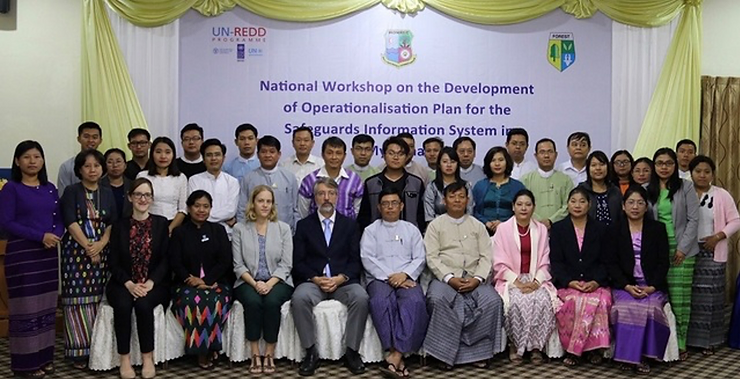To protect its forests and contribute to the global fight against climate change, Myanmar became a UN-REDD partner country in December, 2011 and has since then undertaken a range of REDD+ readiness activities with UN-REDD support. Reducing emissions from deforestation and forest degradation (REDD+) has great potential to deliver environmental and social benefits that go beyond climate change mitigation, such as improving livelihoods for forest-dependent communities, helping to conserve biodiversity-rich forest areas and enhancing ecosystem services like water regulation. However, these efforts may also bring social and environmental risks. For example, REDD+ actions could have negative consequences if they give rise to conflicts over land tenure rights and access to resources, or if they cause land use pressures to shift from one area to another.
In 2010, Parties to the United Nations Framework Convention on Climate Change (UNFCCC) in Cancún, Mexico agreed upon a set of seven social and environmental safeguards for REDD+ to address these risks and promote positive impacts from REDD+. Countries are expected to promote and support these safeguards throughout REDD+ implementation, develop a Safeguards Information System (SIS) that provides information on how the safeguards are being addressed and respected and submit a summary of information to the UNFCCC at least every four years.

In Myanmar, an estimated 70% of the population lives in rural areas. These communities are heavily dependent on the country’s 29 million hectares of forests for basic needs and services. While planning its REDD+ journey, the country strives to protect these communities and create a joint understanding amongst stakeholders about the goals and scope of the country’s approach to safeguards.
The country initiated discussions on defining these goals and the scope of its safeguards approach in 2017. To ensure efficiency and sustainability, Myanmar has been building upon existing systems to meet its safeguards information needs. To date, the country has developed a National REDD+ Strategy and a first Safeguards Summary of Information (SOI), both pending final clearance. Myanmar has also submitted a Forest Reference (Emission) Level to the UNFCCC, and the country is in the process of institutionalising a National Forest Monitoring System, another key pillar of REDD+.
Today, Myanmar is well on its way to meeting the safeguards requirements as the country prepares to operationalise its SIS, a prerequisite for accessing REDD+ results-based payments, according to the UNFCCC. Myanmar has already defined what its SIS should look like, but moving from an SIS design to an operational SIS requires the identification and mobilisation of political, financial and human resources. In February, 2020, representatives from government and civil society organisations met in Nay Pyi Taw to discuss what actions and resources are needed to achieve this. At the workshop, over 40 participants held lively discussions on the scope and institutional arrangements required to manage, host and provide technical inputs to the SIS. They provided feedback on key elements of the draft operationalisation plan, including how to operationalise indicators, SIS software and hardware requirements and capacity building needs.

National Workshops on the Development of the Operationalisation Plan for the Safeguards Information System (Credit: FAO)
The SIS operationalisation plan will be finalised based on inputs from the workshop and will guide the further establishment of Myanmar’s SIS. This important step will support the government of Myanmar in taking REDD+ as a risk-free opportunity to combat climate change and improve the livelihoods of its forest communities.
Useful links:
Read more about the National Workshop on Development of an operationalisation plan for the REDD+ Safeguards Information System (SIS) in Myanmar.
Learn more about the design of Myanmar’s REDD+ Safeguards Information System in English and Myanmar language.
For more information on REDD+ in Myanmar, please visit www.myanmar-redd.org and the Myanmar REDD+ Programme on Facebook.
Authors:

Kristin DeValue
Forest and land governance specialist
FAO Forestry Department

Thinn Thitsar Kyaw

